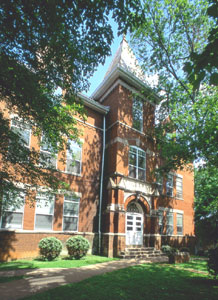
Tennessee Wesleyan College
The institution now known as Tennessee Wesleyan College was established in 1857, when the Holston Conference of the Methodist Episcopal Church South acquired the property of the Athens Female College, chartered in 1854 by the Order of Odd Fellows. The school continued to operate as a women’s college until 1865, when it passed from the control of the Methodist Episcopal Church South to that of the Methodist Episcopal Church, a body composed of Union sympathizers. Renamed East Tennessee Wesleyan College, it initially only admitted male students, but two years later it became coeducational.
Divisions within the church, frequent changes in leadership, and financial hardships plagued the school’s early years. John Spence achieved some stability during his tenure as president. He strengthened the academic program and in 1867, unlike many southern colleges, the college required four years of study for the baccalaureate degree. Upon the death of former U.S. President Ulysses S. Grant, and in an attempt to appeal to potential northern supporters, the institution was renamed Grant Memorial University, an unpopular move with Confederate sympathizers.
In 1889 the Athens college merged with Chattanooga University, with the two campuses governed by a single board of trustees and chancellor under the auspices of the Methodist Episcopal Church. Once again, the name changed to U. S. Grant University. From the beginning, consolidation brought intense rivalry and conflict. At first the school of liberal arts remained in Athens, with the schools of law, medicine, and theology in Chattanooga. When Chattanooga established a competing liberal arts curriculum in 1904, alumni and other supporters of the Athens school filed a lawsuit. The court ruled in favor of the Chattanooga campus, and the Athens branch became a preparatory school for the newly named University of Chattanooga.
The Athens and Chattanooga schools were separated in 1925, and the trustees of the Athens institution adopted the name Tennessee Wesleyan College. President James L. Robb concentrated on building a strong two-year college, which attained recognition for its academic program, particularly in the area of teacher education. The Great Depression and World War II threatened enrollment and financial stability, but returning veterans swelled the student population and necessitated expansion of faculty and facilities.
Under the leadership of Robb’s successor, Dr. LeRoy Martin, Tennessee Wesleyan returned to senior college status in 1954. During the 1960s the school achieved its highest enrollment. In subsequent years, however, the school faced renewed enrollment problems because of the competition from four community colleges established within fifty miles of Athens.
Throughout its history, Tennessee Wesleyan has experienced financial and enrollment problems, but has exhibited remarkable resilience, consistently maintaining its commitment to a strong liberal arts curriculum and to the value of church-related education. Its president in 2001 was Dr. James Dawson.
Suggested Reading
LeRoy Albert Martin, A History of Tennessee Wesleyan College, 1857-1957 (1957)



